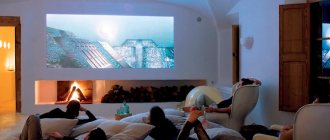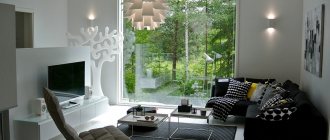Most modern offices are equipped with projectors for making various presentations, viewing photos and videos, and displaying a variety of documents. However, few of those who want to purchase projectors for the office have a good understanding of their functionality and types in order to make the right choice. In this article we will find out what this technology is, what characteristics they have and tell you how to choose a projector for the office.
What types of projectors are there?
By matrix type they are DLP, LCD, CRT, 3LCD and D-ILA type.
- DLPs are equipped with a digital matrix of microscopic mirrors. Lamp light is reflected from a microscopic chip, consisting of rotating mirrors of the smallest size and responsible for its pixel. They have excellent picture quality and are more suitable for home cinema. Disadvantages: high price, poor black color.
- LCDs are equipped with an LCD matrix through which the lamp light projects the image. Such projectors have a low price and are quite light in weight, so they are considered an ideal option for office presentations. Of the minuses: the image quality is not high enough and the black color is very poor.
- CRTs are equipped with cathode ray tubes. They have good color reproduction and rich blacks. No image graininess. Disadvantages: heavy weight, noise, inability to move the projector after fixing, difficult setup.
- 3LCDs are equipped with three LCD matrices, mirror systems that separate the image, and prism systems that collect the image. Highest color rendition, good image quality and reasonable price. Moreover, such projectors consume little energy. Of the minuses: the black color is not “black” enough.
- D-ILAs are equipped with a liquid crystal matrix that does not transmit light, but reflects it, amplifying it in a prism with the help of another lamp. Excellent clarity, color rendition and rich blacks. Of the minuses: high price.
Main characteristics
- Resolution and format. The granularity of the video image depends on the number of pixels of the liquid crystals. High resolution indicates high picture quality. High quality means high price. For office work, an expansion of 800x600 is most often sufficient, and if the budget allows, you can choose 1024x780, 1280x1024, 1600x1200 for a clearer quality of the projected image.
- Luminous flux brightness. The clarity of the picture is equal to the brightness of the light. For projectors, lamp brightness is measured in ANSI lumens (Lm). For large rooms, it is recommended to choose projectors with a brightness above 3500 lumens. For medium-sized audiences, a luminous flux in the range from 2500 to 3500 lumens is suitable. It is recommended to purchase devices with a brightness below 2000 lumens for completely darkened classrooms.
- Contrast. The ratio of the luminous flux of white and black screens is called the projector contrast. This indicator is important only if we are talking about darkened rooms.
- Zoom. Thanks to this indicator, you can reduce the image size without moving the projector.
- Lenses. Projectors with short throw lenses cannot be placed further than five meters from the screen, unlike projectors with long throw lenses.
Contrast
Contrast ratio is the measurement between black and white. A higher contrast ratio means that the image will have more detailed quality. As with the brightness specification, the required contrast ratio is affected by ambient light. This is because ambient light dims contrast as well as brightness.
Projector manufacturers often boast of high contractual rates. However, this does not necessarily mean that these numbers accurately reflect image quality. This is because the contrast ratio does not provide a value for all shades between black and white. This is where ANSI Contrast comes in. ANSI Contrast defines the ratio through a 16-block checkerboard pattern rather than just black and white. This gives a more accurate contrast ratio value.
The projector must have a minimum contrast ratio of 1000:1. (This means the purest white is 1000 times brighter than the deepest black.) Additional features like BrilliantColor and sRGB give you greater control and improved color processing for your projector.
Screen selection
When choosing a screen, you first need to understand the size of the room and the location of the screen. Secondly, think about sound insulation and darkness of the room. The recommended distance between the canvas and the first row of the audience should be no less than twice the screen height, and the distance between the screen and the last row should be no less than six screen heights.
Screen fabrics are: reflective, reflective and matte.
- Reflective reflect the projected light at an angle of incidence. It is best to install such canvases under the ceiling. Thanks to this, the reflection of the image will be directed directly at the audience, which will affect the depicted material.
- Reflective sheets reflect what is being projected directly onto the light source itself, so the projector and the audience should be located opposite the screen.
- Matte canvases reflect light throughout the room, which opens up a wide range of locations for installing the device without any loss of picture quality.
Functional interface
Key features of multimedia projectors include:
- screen menu;
- remote control;
- vertical and horizontal inversion;
- adjustment of light, contrast, quality of the projected image;
- customizing the color palette;
- working with 3D material;
- control using an on-screen mouse;
- correction of keystone distortion of the projected image;
- energy saving mode of use;
- and others.
In some devices you can find the following additional functionality:
- permissibility of changing lenses;
- interchangeable lenses that can change the focus of the lens;
- use as an interactive whiteboard;
- automatic correction and adjustment of keystone distortion;
- the ability to project different colors onto the surface;
- instant disconnection of the device from the network;
- image freezing;
- the ability to repeatedly enlarge a certain area of the image;
- simultaneous display of several images from different sources;
- USB input for flash drive;
- automatic adjustment of the light flow power based on the illumination of the audience;
- and others.
Sources of video information
When choosing a projector, you first need to decide on the sources of information. The vast majority of models currently produced have various digital and analog inputs. Any projector can be used with an external source of information, but some models provide the ability to display presentations from a flash card of a certain amount of information. This allows you to play videos without using a computer. The presence of appropriate connectors must be indicated in the main characteristics of the projector.
Portable or mobile projectors
As you already understand, business projectors installed indoors are called stationary, however, there are also portable ones (also known as mobile or pocket). Pros of portable projectors:
- possibility of free movement;
- little weight;
- small dimensions.
Any user can connect a portable projector. It is ready to work immediately after switching on, but it also has some negative aspects:
- low brightness of luminous flux;
- poor image quality;
- limited functionality.
So, you are working in the field and, despite the listed disadvantages, you have decided to purchase a portable projector. In this case, make sure that:
- the projector you choose has a program for correcting keystone distortion and mechanical lens shift;
- has the highest brightness that such devices only have;
- has the format and resolution required for your types of presentations;
- equipped with sound speakers.
We will decide how to choose a projector for presentations among a huge number of options by reviewing the best projectors for the office of 2021. The review will cover such device manufacturers as: BenQ, Viewsonic, Acer, Epson and Sony.
Light source type
- Gas discharge lamp - most modern projectors use this type of lamp to produce intense light output. They are compact, highly efficient, and consume relatively little energy. The approximate service life of a gas discharge lamp depends on the manufacturer and brightness, and is 2000 – 8000 hours
- LED - small size, low power consumption, long service life (20,000 hours). The disadvantage is low brightness. Typically, such light sources are used in ultraportable projectors
- Laser-LED is a hybrid laser-LED technology, this light source has both a long service life (20,000 hours) and high brightness
Review of the best projectors
BenQ MS517H
DLP projector. Resolution - 800x600. Brightness - 3300 Lumens. Energy consumption - 270 W. Weight - 1900 g.
Possibilities:
- SmartEco Mode Adjusts light output for maximum energy savings while maintaining the best contrast-to-brightness ratio of the projected image.
- LampSave mode Allows you to reduce the frequency of lamp replacement, thereby significantly reducing the cost of servicing the device.
- EcoBlank mode If the projector is not used for three minutes, it automatically switches to a mode that allows you to save energy.
- 3D format support.
ViewSonic PJD5151
DLP projector. Resolution - 800x600. Brightness - 3300 Lumens. Energy consumption - 260 W. Weight - 2200 g.
Possibilities:
- SuperColor Technology A special technology that provides the highest color reproduction over a wide range of colors.
- Smart Restart function If the projector is not used for three minutes, it automatically enters standby mode.
- Mouse Button This button allows you to control the projector in the style of a computer mouse.
- Lamp door on top Facilitates the process of replacing lamps and servicing the device.
- Templates built into the projector.
- 3D format support.
Acer X113
DLP projector. Resolution - 800x600. Brightness - 2800 lm. Energy consumption - 235 W. Weight - 2500 g.
Possibilities:
- Acer Color Technology Guarantees bright and clear images of text and pictures even from a long distance.
- Acer Dust Shield does not allow dust to accumulate, so the brightness of the projected image is not lost, but the need to frequently service the device is lost.
- Has 4 ceiling mounting options.
- Switch to economical standby mode.
- 3D format support.
Epson EB-S31
3LCD projector. Resolution - 800x600. Brightness - 3200 lm. Energy consumption - 200 W. Weight - 2400 g.
Possibilities:
- A universal projector suitable for both home and office.
- Rich colors even in daylight.
- Possibility of broadcasting material simultaneously from different sources.
- Body Slider A slider located on the body allows you to quickly correct keystone distortion of the projected image.
- Economy mode If there is no signal for 5 minutes, it automatically enters sleep mode, in which energy consumption is reduced by 70%.
Scaling and aspect ratio
Modern technology makes projection easier than ever. Scaling factors and lens ratios help determine the range of screen sizes that the projector works best with, as well as the required distance between devices for optimal image clarity. Lens shift also helps position the projected image in the ideal position for the screen.
For those who like to project onto different screens, the scaling feature allows you to adapt and change the image to fit different screen sizes without having to move the projector. While you'll sometimes see digital projection, optical zoom is ideal for projectors. The motorized zoom feature means you can control the zoom from the remote control. On the other hand, manual mode means that you will need to adjust it yourself. Scaling factors indicate the maximum scaling potential of your projector. For example, 2.0x magnification means the image can be magnified twice at maximum magnification.
When you project an image onto a screen, it's called "casting." (Think of it as the projector "throwing" the image onto the screen.) Throw distance refers to how close or far you need to place the projector from the screen. Therefore, the lens projection distance helps estimate the space requirements for optimal image production. For example, let's say the projector you're interested in has a throw ratio of 1:1 to 2:1. If you have a 6-foot wide screen, that throw ratio means the projector needs to be mounted 6 to 12 feet from the screen.
Lens shift allows you to move the lens itself up and down (vertical shift) or side to side (horizontal shift). This allows you to place the projector in the ideal location by moving the lens to achieve the optimal projection angle and direction.











